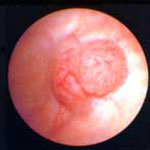This is a retrospective audit to check operative documentation & to assess compliance with the recommendations that all patients undergoing a first tumour resection for non-muscle invasive bladder cancer should have muscle included in the biopsy specimen and should receive a single-dose, intravesical instillation of Mitomycin C.
Download the audit essentials (as a PDF)
Background to the audit
 A histology specimen containing muscle is required to stage transitional cell carcinoma (urothelial cancer; TCC) of the bladder accurately. It can also be indicative of adequate depth of resection.
A histology specimen containing muscle is required to stage transitional cell carcinoma (urothelial cancer; TCC) of the bladder accurately. It can also be indicative of adequate depth of resection.
A single post-operative instillation (SPI) of chemotherapy, using Mitomycin C, has been shown to reduce recurrence rates of non-muscle invasive bladder cancer (NMIBC) and should be standard of care unless contraindicated. Thus, the presence of muscle in the specimen and the use of SPI of Mitomycin C at the time of first TURBT are surrogate markers of quality.
This audit assesses compliance with suggested standards (these have been discussed at BAUS section of Oncology meeting 2018 and may be modified as a consequence of pilot studies carried out by the section).
The standard
For first TURBTs, a rate of 70% for the presence of muscle in NMIBC (high-grade) and 60% for administration of an SPI of Mitomycin C for all NMIBC should be achieved.
Assessment of local practice
Perform a retrospective review of consecutive patients undergoing their first TURBT using a spreadsheet to collect the data.
Data items to be collected
- a list of patients having first TURBT (from theatre secretaries or theatre record system);
- the date of the procedure;
- the pathological findings (from the pathology report);
- a record of whether detrusor muscle was present in the specimen of NMIBC; and
- a record of whether SPI of Mitomycin C was given peri-operatively (from theatre coding).
Suggested numbers
50 consecutive patients
Estimated time required
10 Hours
Suggestion(s) for change if targets are not met *
- Present data at the departmental meeting;
- Discuss any barriers to compliance e.g.
- need for muscle paralysis;
- Consultant supervision (compare rates based on grade of operating surgeon); and
- ability of recovery staff to deal with intra-vesical chemotherapy etc.
- Re-audit once any improvements have been introduced.
* please consider if any other improvements are possible, even if all targets have been met
Further work
In time, you will be able to assess the recurrence rates for this cohort at three and 12 months. Increasing the numbers studied will make these data more meaningful.
Many centres achieve TURBT on a day-case basis. Consider if this is possible in your centre, without compromising recurrence rates.
There is evidence that quality of documentation is also an important marker of quality in TURBT; check that bladder diagrams are recorded in the notes and that the findings of an EUA are documented.
Publication & contact details
Published Dec 2018 - Mr Dominic Hodgson, Queen Alexandra Hospital, Portsmouth
Email the author
← Back to essential audits